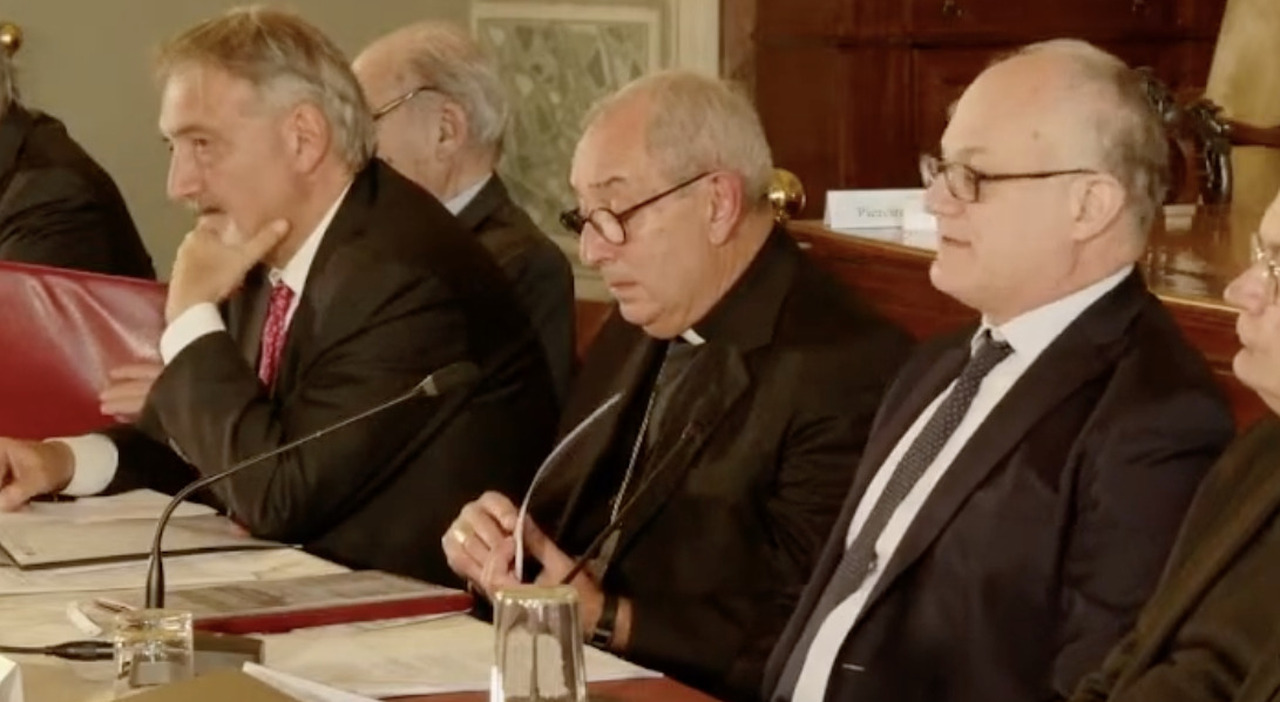Tuesday 20 February 2024, 12:03
There are exactly 308 days left to the start of the Jubilee and in the Hall of Reconciliation of the Lateran Palace, the same historic hall in which the Lateran Pacts were signed, the Mayor of Rome, Roberto Gualtieri, the President of the Lazio Region, Francesco Rocca and Cardinal Angelo De Donatis agree on the need for a common path, overcoming walls and fences, capable of putting all available energies into circulation and giving the Capital and its inhabitants a powerful injection of hope. 'We must avoid annoying polarization and look at the good of our communities, we must get in touch with our communities and for this I am happy with the relationship that has been created with the Mayor. I feel on me the responsibility to think about the last ones' were the immediate words of President Rocca. The opportunity presented itself thanks to a celebratory event: the commemoration of a historic conference on the evils of Rome promoted in 1974. The Catholics of that time, in a rather tense political climate, laid the foundations for a new spirit that was able to tackle thorny issues such as degradation, poverty, marginalization with privileged attention to the suburbs. In the message sent to the Vicariate by the President of the Republic, Sergio Mattarella, it was remembered that 'over the years those appeals to solidarity, hospitality, assistance still retain their value and relevance in the face of new forms of marginalization and loneliness that often accompany the old ones'. Today's Rome is of course very different from how it appeared fifty years ago, it has developed, grown, yet despite progress several knots that had already been highlighted in the Seventies have remained largely unresolved, with an evident weakening of the social fabric as all the conference participants have highlighted in the interventions that have followed. Although there are no longer the villages with the shacks full of immigrants mainly from the South, Mayor Gualtieri has reminded that today Rome, in its complexity, also includes, for example, Tor Bella Monaca which has become the largest drug square in Europe. The problems therefore remain multiple, complex, often overlapping and require enormous efforts. The updated picture on the 'evils' that afflict the city was offered by the director of the diocesan Caritas, Justino Trincia, with numbers, data and projections. The average age of the Romans has risen, reaching 46 years; single-person families have reached 46% with peaks touching 60% in the historic center. The percentage of foreigners stands at 14%, almost double the national average. To the resulting social fragmentation are then added strong inequalities for basic services, such as health for example. Caritas then denounces the excessive and worrying increase in mental distress and mental illness. This picture is compounded by the terrifying gap between those who can afford to resort to private doctors without having to wait even weeks for a visit, even for important pathologies. After health in the list of sectors in difficulty there is no lack of school: 'There is a widespread educational poverty that involves all age groups'. Finally, Caritas puts the labor sector and housing shortage. Morale: 'A high and long-term vision is needed, which puts the good of all at the center of its action' summarized Luigina Di Liegro, head of the Don Luigi Di Liegro foundation. It is from these premises that the Vicariate's offer to the collaboration of the Municipality and the Region was born. We must cultivate hope, and all commit to making Rome a city of hope in view of the Jubilee' De Donatis and the Mayor repeated, both quoting the phrase that Pope Francis pronounced during the Te Deum mass at St. Peter's, last December 31. Gualtieri then recognized that 'on the eve of a Jubilee full of hope, in a city that is transforming, also marked by inequalities it is appropriate to resume the teaching of the 1974 conference and from what was done at that juncture'. The Church knew how to speak to the country, identifying an agenda that was subsequently adopted by others.
© ALL RIGHTS RESERVED
This article is automatically translated
